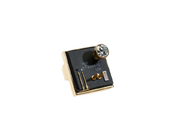Difference between revisions of "Cubic zirconia"
m (Text replace - "== Authority ==" to "== Sources Checked for Data in Record ==") |
|||
| (8 intermediate revisions by the same user not shown) | |||
| Line 1: | Line 1: | ||
| + | [[File:Cubic zirconia MFA 2006453.png|thumb|Cubic zirconia in ring<br>MFA# 2006.453]] | ||
[[File:CZ_brilliant.jpg|thumb|Cubic zirconia]] | [[File:CZ_brilliant.jpg|thumb|Cubic zirconia]] | ||
== Description == | == Description == | ||
| Line 7: | Line 8: | ||
CZ; cubic zirconium; Matura diamond; imitation diamond; Pink Ice; Fianit (Russian); circonita (Esp.); zircão cúbico (Port.) | CZ; cubic zirconium; Matura diamond; imitation diamond; Pink Ice; Fianit (Russian); circonita (Esp.); zircão cúbico (Port.) | ||
| + | [[File:Cubic zirconia Raman RRUFF R040142.png|thumb| Raman spectrum of synthetic cubic zirconia; [https://rruff.info/cubic%20zirconia/display=default/R040142 RRUFF]]] | ||
| + | ==Physical and Chemical Properties== | ||
| − | + | * Cubic zirconia has a low thermal conductivity while diamonds have a high thermal conductivity | |
| − | + | * Luster = adamantine | |
| − | Cubic zirconia has a low thermal conductivity while diamonds have a high thermal conductivity | + | * Cleavage = none |
| − | + | * Fracture = conchoidal | |
| − | Luster = adamantine | + | * Fluorescence = often yellow to greenish in SW and yellow to orangish in LW, but not diagnostic |
| − | + | * Birefringence = none | |
| − | |||
{| class="wikitable" | {| class="wikitable" | ||
| Line 22: | Line 24: | ||
|- | |- | ||
! scope="row"| Melting Point | ! scope="row"| Melting Point | ||
| − | | 2750 | + | | 2750 C |
|- | |- | ||
! scope="row"| Density | ! scope="row"| Density | ||
| − | | 5.6-6.0 | + | | 5.6-6.0 g/ml |
|- | |- | ||
! scope="row"| Refractive Index | ! scope="row"| Refractive Index | ||
| 2.15-2.18 | | 2.15-2.18 | ||
| + | |- | ||
| + | ! scope="row"| Dispersion | ||
| + | | 0.058-0.066 (strong fire) | ||
|} | |} | ||
== Comparisons == | == Comparisons == | ||
| − | [[media: | + | [[media:download_file_446.pdf|Properties of Natural and Simulated Diamonds]] |
| − | |||
| − | |||
| − | |||
| − | |||
| + | ==Resources and Citations=== | ||
| + | * Gem Identification Lab Manual, Gemological Institute of America, 2016. | ||
* G.S.Brady, ''Materials Handbook'', McGraw-Hill Book Co., New York, 1971 | * G.S.Brady, ''Materials Handbook'', McGraw-Hill Book Co., New York, 1971 | ||
| − | |||
* Random House, ''Webster's Encyclopedic Unabridged Dictionary of the English Language'', Grammercy Book, New York, 1997 | * Random House, ''Webster's Encyclopedic Unabridged Dictionary of the English Language'', Grammercy Book, New York, 1997 | ||
| − | |||
* ''The American Heritage Dictionary'' or ''Encarta'', via Microsoft Bookshelf 98, Microsoft Corp., 1998 | * ''The American Heritage Dictionary'' or ''Encarta'', via Microsoft Bookshelf 98, Microsoft Corp., 1998 | ||
| − | + | * Wikipedia: [https://en.wikipedia.org/wiki/Cubic_zirconia Cubic_zirconia] (Accessed Sept. 20, 2005 and Dec 2022) | |
| − | * Wikipedia | ||
[[Category:Materials database]] | [[Category:Materials database]] | ||
Latest revision as of 10:35, 4 January 2023
Description
A crystal clear, synthetic Diamond Gemstone. Cubic zirconia (CZ) are very hard and have a high refractive index. It is composed of a single crystal of synthetically prepared Zirconium oxide. During manufacture, calcium or yttrium are added as a metal oxide stabilizer, which allows the growth of the single crystal. The technique was first researched in France in the 1960s, then perfected in Russia in 1973 at the Lebedev Physical Institute. Commercial imitation diamonds have been on the market since 1976. Some coatings have been applied in recent years that make the stone visually indistinguishable from diamonds. The variations between the two stones are: 1) CZ are flawless, unlike natural diamonds, and 2) CZ has a lower thermal conductivity, higher dispersion, higher specific gravity, and often a poorer faceted cut.
Synonyms and Related Terms
CZ; cubic zirconium; Matura diamond; imitation diamond; Pink Ice; Fianit (Russian); circonita (Esp.); zircão cúbico (Port.)

Physical and Chemical Properties
- Cubic zirconia has a low thermal conductivity while diamonds have a high thermal conductivity
- Luster = adamantine
- Cleavage = none
- Fracture = conchoidal
- Fluorescence = often yellow to greenish in SW and yellow to orangish in LW, but not diagnostic
- Birefringence = none
| Mohs Hardness | 8.5 |
|---|---|
| Melting Point | 2750 C |
| Density | 5.6-6.0 g/ml |
| Refractive Index | 2.15-2.18 |
| Dispersion | 0.058-0.066 (strong fire) |
Comparisons
Properties of Natural and Simulated Diamonds
Resources and Citations=
- Gem Identification Lab Manual, Gemological Institute of America, 2016.
- G.S.Brady, Materials Handbook, McGraw-Hill Book Co., New York, 1971
- Random House, Webster's Encyclopedic Unabridged Dictionary of the English Language, Grammercy Book, New York, 1997
- The American Heritage Dictionary or Encarta, via Microsoft Bookshelf 98, Microsoft Corp., 1998
- Wikipedia: Cubic_zirconia (Accessed Sept. 20, 2005 and Dec 2022)

